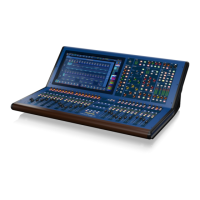134 HD96-24-CC-TP User Manual
Pre-delay
0 to 990 milliseconds (ms) of pre-delay is available allowing a very wide range of control. Delays of less than 30ms closely integrate the direct and reverberant sounds;
often a desirable feature on percussive sounds. Delays of 50ms or more cause the direct and reverberant sounds to separate and convey a feeling of depth and distance
to the simulated environment.
Pattern
The pattern control alters the ‘density’ of the early reections. It is adjustable from 0 to 9 as shown on the display, with 0 giving a low density or ‘grainy’ character to
the early reections and 9 producing a high-density eect.
Level
The level control functions convincingly as a ‘depth’ control, altering the apparent distance between the sound source and the listener. It is adjustable from 0 to 9 as
shown on the display, with 0 being relatively distant and 9 bringing the sound source closer.
Decay
The reverberation decay time is adjustable from 0.1 to 18 seconds, depending on room size, changing the reverberant eld from a virtually dead sound to a totally
surreal eect. Short decay times, under one second, are essential for authentic small room simulation and also extremely useful for ambience applications where
classic reverberation is not wanted. Reverb times of 1 to 4 seconds cover the majority of normal applications where classic reverberation is required. Longer decay
times are available for special eect applications.
LF key
LF is adjustable to ±7, depending on room size and decay time, as shown in the GUI. An increase in LF decay time is generally desirable on simulations of large halls,
since low frequency sounds suer less than higher frequencies from absorption in air. Very small spaces usually need the ‘thin’ sound created by reducing LF decay.
HF key
HF is adjustable to ±7. The HF decay control sets the absorption characteristic of the simulated space. In reality, large environments feature considerably reduced high
frequency decay times due to air absorption. A smaller room will feature greater HF decay time if the walls are tiled and the room is empty than if the room contains
soft furnishings and curtains. The wide range of control provided will allow a suitable setting to be chosen to enhance realism in most applications.
Room size
Room size is adjustable from 8 to 90 linear metres, representing a wide range of room volumes. Since the acoustic character of a given environment depends not only
on the reverberation time and construction of the room, but also to a great extent on its volume. The room size control is, in fact, essential if authentic simulation of a
range of dierent sized environments is required. Small room sizes give a conned, ‘box-like’ sound. Medium room sizes suggest a room or small hall, whereas large
room sizes suggest a large hall or cathedral. Again, there is no substitute for experimentation.
Special eects programs
This section gives details of the eect’s programs available on the DN780 Reverb eect.
Direct signal
Eects such as ADT and Echo rely on a suitable level of direct (dry) signal being added on the mixing console. Since this is largely a question of taste, no precise
instructions are included here. It is recommended that, as a general principle, direct signal is initially set at a normal operation level without any eect present. The
eect is then increased in level as required.
Delay
PRE-DELAY control adjusts the delay time within the range 0 to 2.0 seconds.
REV button mutes the eect.
Preset parameters: On selecting this eect program, delay is set to 200 ms.
Stereo mix: The signal’s at left and right outputs are both delayed by the same amount as set using the PRE-DELAY control, that is, they are essentially monophonic.

